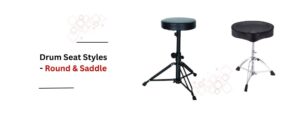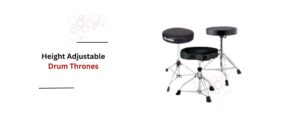A good drum throne isn’t just a seat, it’s the base of your drumming performance. A good throne helps you to be comfortable and maintain proper posture so you can play longer without fatigue. Are you a rock drummer who needs a hard hit, or are you a jazz player who needs some soft motion, so choosing the perfect drum throne according to your playing type is very important. To ensure the best setup of drum throne at your home, read – The Perfect Drum Throne Setup For Home Recording Studios!
From heights that adjust to ergonomic cushions and strong bases, each feature serves to influence stability and performance. However, throne selection is only part of the equation; throne utilization drives maximum efficiency, control and endurance. In this guide, we’re fleshing out specific variables not to ignore, such as throne types, materials, and positioning tips to enhance drumming experience.
So, whether you are having a little jam session at home, recording in the studio, or shredding on stage, a good quality and tuned drum throne can help you perfect the craft. Now, let’s find the right spot for your groove!
How to Choose the Right Drum Throne
1. A Guide to the Different Types of Drum Thrones
Drum thrones vary in shapes and designs, serving various needs:
Round Thrones – Allow even distribution and movement, making them great for drummers that have the need to move as much as possible.
Saddle Thrones – Provide more thigh support, limiting fatigue during long playing sessions.
2. Adjustability vs Stability
Height adjustment settings to suit your body type and playing technique. Hydraulic thrones can be adjusted quickly and easily, while spindle-adjusted thrones offer stability. And make sure that it has a sturdy base with double-braced legs and a non-slip rubber grip so that it doesn’t slide mid-sesh.
3. Testing for Cushioning and Comfort
Playing drums for long periods of time is tough on your lower back and hips. Choose one with a high-density foam or memory foam padding for the most comfort. If you have back pain, choose one with lumbar support or a backrest.
4. Portability vs. Durability
For a touring drummer, you want to keep it lightweight, so a collapsible drum throne is essential for easy transportation. But if you’re playing primarily in a studio or home setting, then prioritize durability and sturdiness over portability.
Check the best seats for heavy-duty drum sets, click on – The Best Drum Thrones for Heavy-Set Drummers: A Complete Buying Guide!
5. Matching Your Playing Style
Another factor in choosing the right drum throne is your preferred drumming genre and technique:
- Rock & Metal Drummers – Require padded throne that is stable and solid enough to take forceful, energetic playing.
- Jazz & Funk Drummers – Enjoy a more rounded, seat which is easier to move and adjust quickly.
- Electronic Drummers – Unless you are in an arena touring the world, you can go for a smaller and lighter throne without risking comfort.
Drum Throne Positioning: Maximize Your Setup
1. Best Position For Your Posture: Adjust the Height
You want your thighs to be a little downward angled, this will help blood circulation and prevent you from putting pressure on your lower back. Keep your feet flat on the pedals and sit upright to avoid fatigue.
2. Get in Place for Relaxation and Effectiveness
The distance of your throne to your drum kit is important. Your knees should be at a comfortable angle, and you can comfortably reach all your drum components without excessive stretching.
3. Engaging Core Muscles for Stability
The core is the fulcrum for all the limbs, and therefore a stable core prevents superfluous movement and allows the drumming to be more efficient. Firm up your core muscles with planks and seated balance drills to improve endurance and reduce strain on your lower back.
4. Avoiding Common Mistakes
- Sitting Too Low or Too High – If you sit too low, your range of motion is restricted, and if you sit too high, you risk balance issues and leg fatigue.
- Neglecting Back-Relations – If playing the throne causes discomfort, you might want to get a throne with back support which will help keep you in good posture.
- Ignoring Seat Angle – Certain thrones have slight tilting features. Try out a few different angles and see what gives your playing comfortable adjustment.
5. Maintaining Your Drum Throne
To maintain your drum throne in good shape for years to come, use the following maintenance tips:
- Tighten screws and bolts that have become loose.
- Wipe down the seat with a wet cloth to eliminate dust and sweat residue.
- Apply lubricant to moving parts to allow ease of height adjustments.
- Always store when not in use to avoid wearing it down.
Final Thoughts
Choosing a suitable drum throne is a personal matter that will invariably affect the comfort level for playing. Make sure you select a throne with comfort, stability, and adjustability to meet your needs. Are you unaware of the drum throne setup? Click on – Step-by-Step Guide To Assembling Your Drum Throne!
With proper use of the drum throne, fatigue and strain are reduced while aiding good posture which improves overall drumming performance. The right throne will make a difference in every strike, so invest in one that fulfills your requirements.



